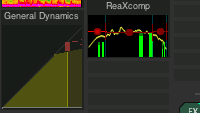It’s got a $60 license for nearly everyone, you can evaluate it for free, and now Reaper – yet again – adds a ton of well-implemented power features. Reaper 6 is the newest edition of this exceptionally capable DAW.
New in this release:

Use effects plug-ins right from the tracks/mixer view. So, some DAWs already have something like a little EQ that you can see in the channel strip visually, or maybe a simple compressor. Reaper has gone further, with small versions of the UI for a bunch of popular plug-ins you can embed wherever you want. That means less jumping in and out of windows while you patch.
You get EQ, filtering, compressor, and more. (ReaEQ, ReaFIR, ReaXcomp, graphical JSFX, etc.)

Powerful routing/patching. The Routing Diagram feature gives you an overview of how audio signal is routed throughout the environment, which makes sends and effects and busing and sidechaining and so on visual. It’s like having a graphical patchbay for audio right inside the DAW. (Or it’s like the ghost of the Logic Pro Environment came back and this time, average people actually wanted to use it. )
Auto-stretch audio. Now, various DAWs have attempted this – you want sound to automatically stretch and conform as you adjust tempo or make complex tempo changes. That’s useful for film scoring, for creative purposes, and just because, well, you want things to work that way. Now Reaper’s developers say they’ve made it easy to do this with tempo-mapped and live-recorded materials (Auto-stretch Timebase). This is one we’ll have to test.

Make real envelopes for MIDI. You can draw continuous shapes for your MIDI control adjustments, complete with curve adjustment. That’s a bit like what you get in Ableton Live’s clip envelopes, as well as other DAWs. But it’s a welcome addition to Reaper, which increasingly starts to share the depth of other older DAWs, without the same UI complexity (cough).
It works with high-density displays on Mac and PC. That’s Retina on Mac and the awkwardly-named HiDPI on PC. But the basic idea is, you can natively scale the default theme to 100%, 150%, and 250% on new high-def displays without squinting. Speaking of which
There’s a new tweakable theme. The new theme is set up to be customizable with Tweaker script.
Big projects and displays work better. The developers say they’ve “vastly” optimized 200+ track-count projects. On the Mac, you also get faster screen drawing with support for Apple’s Metal API. (Yeah, everyone griped about that being Mac-only and proprietary, but it seems savvy developers are just writing for it and liking it. I’m honestly unsure what the exact performance implications are of doing the same thing on Windows, though on the other hand I’m happy with how Reaper performs everywhere.)
And more. ” Dynamic Split improvements; import and render media with embedded transient information; per-track positive or negative playback offset; faster and higher quality samplerate conversion; and many other fixes and improvements.”
Honestly, I’m already won over by some of these changes, and I had been shifting conventional DAW editing work to Reaper as it was. (That is, sure, Ableton Live and Bitwig Studio and Reason and whatever else are fun for production, but sometimes you want a single DAW for editing and mixdown that is none of those others.)
Where Reaper stands out is its extraordinary budget price and its no-nonsense, dead-simple UI – when you really don’t want the DAW to be too creative, because you want to get to work. It does that, but still has the depth of functionality and customization that means you feel you’re unlikely to outgrow it. That’s not a knock on other excellent DAW choices, but those developers should seriously consider Reaper as real competition. Ask some users out there, and you’ll hear this name a lot.
Now if they just finish that “experimental” native Linux build, they’ll really win some nerd hearts.
Those of you who are deeper into the tool, do let us know if you’ve got some tips to share.